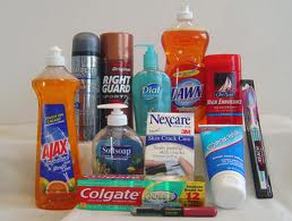Toothpaste: Do you need it? What’s in it?
The Ancient Egyptians are said to have first developed toothpaste made from ashes, eggshells, pumice and water. The Greeks and Romans added crushed bones and oyster shells. And as reported in Huffpost.com, “the very essence of early tooth care was “abrasion,” and it stayed this way for a very long time.”
But as reported in the International Dental Journal, abrasion is just about the worst thing you can do for your teeth and gums. Toothpaste may be the source of tooth enamel damage and heightened sensitivity. Instead of making your teeth whiter, brushing with some toothpaste thins enamel, and creates a darker appearance — and consumers, in perpetual search for whiter teeth, brush more.
Abrasives are common ingredients in toothpaste and combined with “vigorous brushing, damage results in a unique “sandblasted” effect on tooth enamel. Most people don’t use the recommended “pea-sized squirt” but instead may load the bristles with the notion that if a little is good, more is better.

The Oldest Known Recipe For A Toothpaste Possibly Comes From Ancient Egypt. Credit: Realmofhistory.com
Consumers can purchase a myriad of toothpaste with different claims: to whiten teeth, freshen breath, and there are pastes for sensitive teeth too. But when shopping for toothpaste, be sure to read the label. Living in Cuenca, we have many of the brands marketed in the U.S. One thing for sure, avoid toothpaste (and all products) with triclosan.
According to ConsumerReports.com, “If you’ve been concerned about your toothpaste containing triclosan — an antibacterial that helps prevent gingivitis — the good news is that it’s essentially gone from the U.S. market, though it’s still technically permitted.

Read the ingredient label carefully to avoid Triclosan.
Until a few months ago, Colgate Total still contained the ingredient. But it has now been updated to a triclosan-free formula, renamed Colgate Total SF.”
The U.S. Food & Drug Administration (FDA) says that studies are underway to evaluate the safety of triclosan.
Consumer Reports writes that triclosan has been removed from many kinds of toothpaste, “Because of widespread circulation of research probably suggesting that triclosan may disrupt some thyroid hormones and immunity, and contribute to antibiotic resistance overall, says Tunde Akinleye, a chemist in Consumer Reports’ food safety division. (Triclosan was banned from hand soaps and body washes in 2017.)”
That’s good news for consumers, Akinleye says, “because triclosan is just not worth the risk.” So if you have a tube of the old formula in your bathroom, we suggest tossing it.”
According to Consumer Reports, read the ingredient labels:
ADA seal of acceptance: A toothpaste bearing this seal from the American Dental Association must be safe and effective at whatever its label claims. It also must contain fluoride, have no ingredients that “cause or contribute to” decay and not harm teeth.
Abrasives: Calcium carbonate and modified silica help to remove food debris and surface stains.
Baking soda: Toothpaste with baking soda (sodium bicarbonate) shows some promise for reducing plaque and may slightly decrease gum bleeding from gingivitis compared with toothpaste that doesn’t have it.
Desensitizers: Used regularly, ingredients such as sodium citrate, casein phosphopeptide and potassium nitrate may help relieve uncomfortable sensitivity. They “are effective in some people and not in others,” says Richard Niederman, professor at the NYU College of Dentistry.
Fluoride: This active ingredient comes in several different forms (including sodium fluoride and stannous fluoride) and helps protect teeth from decay. “Fluoride is effective at reducing cavities by 20 to 30 percent,” Niederman says. Stannous fluoride may also help with sensitivity and gum inflammation. You can buy fluoride-free toothpaste, but it probably won’t help reduce cavities.
Sodium lauryl sulfate (SLS): SLS is called a detergent, but it has little cleaning power. Instead, it creates foam to help circulate the toothpaste into nooks and crannies. Some people may get canker sores or experience peeling of mouth tissue in as little as one use. If you’re among them, look for SLS-free or “nonfoaming” toothpaste.
Whiteners: Basic whiteners include hydrogen peroxide, which chemically lightens teeth, and polyphosphates, such as sodium hexametaphosphate, said to help with enamel staining. But some experts say these aren’t concentrated enough or in contact with tooth surfaces long enough to make a noticeable difference. And polyphosphates may cause mouth irritations.
Xylitol: Some small studies suggest that toothpaste with both fluoride and xylitol may be better at cavity prevention than a fluoride-only product. But experts say that even brushing several times daily is unlikely to deliver enough xylitol to provide a benefit.
The Toothpaste Takeaway
Certainly, don’t use abrasives casually. Dr. Robert B. Shelton writes that there are many “other modifying factors that can enhance toothpaste abrasivity, such as amount of toothpaste, size of brush, bristle size and texture, frequency of brushing, length of brushing time, force of brushing, brushing speed or strokes per minute, recent soda consumption, recent bleaching, dryness of mouth, and many more factors.” He advises that a small-headed soft toothbrush is best and that a toothbrush should last at least six months, or more. If the bristles bend within a few weeks then the brushing force is excessive. Read more about the hardness of teeth compared to products on the market that claim to “whiten.” Stay away from big toothbrushes and highly abrasive toothpaste such as ‘whitening toothpaste.’
Huffpost.com also describes how “toothpaste abuse” has been shown to cause tooth damage. There are two different schools of thought from dentists. Some suggest ditching toothpaste entirely as too abrasive, and instead, use an electric toothbrush and just water. Others advise not throwing the baby out with the bathwater, and advocate for the combined use of toothpaste and tooth brushing, as some of the ingredients are shown to prevent tooth decay and gum disease — but technique matters.
Read here from the American Dental Association who wisely advises that your diet is one of the most important contributing factors to healthy teeth and gums.
- Clean between teeth daily once a day. Tooth decay-causing bacteria still linger between teeth where toothbrush bristles can’t reach. This helps remove plaque and food particles from between the teeth and under the gum line.
- Eat a balanced diet that limits sugary beverages and snacks.
- See your dentist regularly for prevention and treatment of oral disease.
Watch how Mr. Bean brushes his teeth!
Sources:
American Dental Association. Brushing your teeth.
Consumer Reports. What’s in your toothpaste anyway?
FDA.gov. 5 Things to Know About Triclosan.
Huffington Post. The History of Toothpaste: From 5000 BC to the Present.
Huffington Post. Too much toothpaste damages teeth.
SheltonDentistry.com. Toothpaste abrasivity.
_____________________________________
Susan Burke March, a Cuenca expat, is a Registered and Licensed Dietitian, a Certified Diabetes Educator who specializes in smart solutions for weight loss and diabetes-related weight management. She is the author of Making Weight Control Second Nature: Living Thin Naturally—a fun and informative book intended to liberate serial dieters and make healthy living and weight control both possible and instinctual over the long term. Do you have a food, nutrition or health question? Write to me at SusanTheDietitian@gmail.com





















